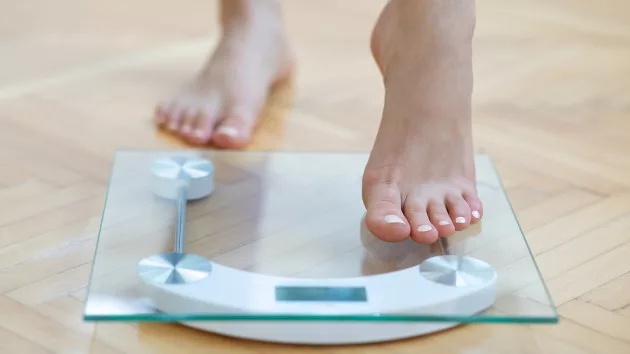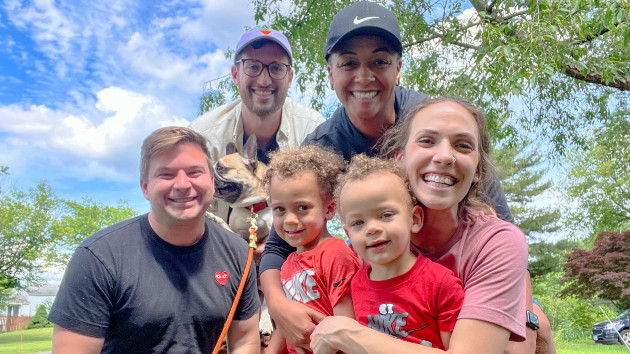(NEW YORK) — Francesca McGinn, a 16-year-old high school student from Chicago, struggled with her weight nearly her entire life.
It wasn’t until late last year, after seeing a family member have success taking a medication for weight loss, that Francesca said she thought there could be a different way for herself.
In her first appointment with a doctor who specializes in pediatric weight management, Francesca said she was told for the first time in her life that she was not to blame for her weight issues.
Following her appointment, Francesca began to take Wegovy, an injectable medication that is U.S. Food and Drug Administration-approved for weight loss for patients with severe obesity, or who are overweight and have one or more weight-associated conditions like high blood pressure or high cholesterol.
In 2022, the FDA also approved Wegovy as a treatment for teenagers with obesity.
Since starting the medication, Francesca said she has both lost weight and changed the way she thinks about herself and her body.
“It lifted off a weight of just stress of constantly thinking of what I need to stop eating and what I need to start eating,” she told ABC News’ Good Morning America. “In fifth grade, I started worrying about what I was eating, and there were some points where I thought about not eating … This medicine really changed my thinking.”
Over the past several years, medications that can lead to weight loss, from Wegovy to Zepbound, Ozempic and Mounjaro, have changed the landscape of obesity medicine, from how weight loss is treated medically to how the public perceives thought about obesity.
As the drugs have become more widely available and skyrocketed in popularity, a rising number of teenagers, specifically teenage girls, like Francesca, have tapped into their use.
Among the young people being prescribed GLP-1 medications, an overwhelming majority, 60%, are female, according to data published in May in the Journal of the American Medical Association.
Among all young people, the number of prescriptions for GLP-1 weight loss medications rose from 8,000 to more than 60,000 between 2020 and 2023.
Why more girls than boys are on weight loss medications than boys
Pediatric endocrinologists from across the country who spoke with GMA said the reasons why more girls are prescribed medications for weight loss are varied.
Sophia, a 17-year-old from Colorado, said she started taking weight loss medications last year to help treat polycystic ovary syndrome, or PCOS, a reproductive hormone imbalance that can cause problems with the menstrual cycle and lead to the formation of multiple ovarian cysts and infertility, according to the U.S. Office on Women’s Health.
After going on a medication used for weight loss, Sophia, who asked that her last name not be used, said she has lost around 80 pounds in total.
“It was like a light at the end of the tunnel,” Sophia said. “It’s given me a new life. I have a lot more confidence. I feel a lot better. My mood is a lot better … I don’t feel the struggle.”
The fact that girls battle hormonal and insulin-related conditions like PCOS, which the medications are proving to be able to treat, is one reason they are being prescribed more, according to Dr. Melanie Cree, Sophia’s doctor and a pediatric endocrinologist at Children’s Hospital Colorado.
The exact cause of PCOS is unknown, but people with this condition have higher levels of androgens, such as testosterone, and insulin resistance, which is a risk factor for Type 2 diabetes.
Both Ozempic and Mounjaro are approved by the U.S. Food and Drug Administration to treat Type 2 diabetes, but some doctors prescribe the medication “off-label” for weight loss, as is permissible by the FDA.
Like Wegovy, Zepbound is FDA-approved as a weight loss management treatment for people with obesity, or those who are overweight with at least one related underlying condition, such as high blood pressure. Both Zepbound and Mounjaro contain the same active ingredient, tirzepatide, while Ozempic and Wegovy both contain a different active ingredient, semaglutide.
“When girls have PCOS and extra weight, they have a much higher risk for type 2 diabetes, they have insulin resistance, extra fat and inflammation in their liver, higher rates of depression and really seem to struggle,” said Cree, who is currently leading a research study on the impact of GLP-1 drugs on young women with PCOS. “We’ve really seen how, how much weight loss makes a difference in this patient population, and how badly these patients are struggling.”
Young girls are particularly at risk for complications from obesity and type 2 diabetes, according to experts including Dr. Caren Mangarelli, a pediatrician who works with the Lurie Children’s Hospital’s Pediatric Wellness & Weight Management Program, citing data showing among the growing number of young people with Type 2 diabetes, the majority are female.
“We’re seeing younger and younger kids with disease processes that we think of as adult diseases,” Mangarelli said. “And most young adults and adolescents who have type 2 diabetes also have obesity. They usually come together.”
Doctors say they are willing to put teenagers on medications for weight loss because they know the long-term damage that can come from having type 2 diabetes in childhood.
“We know that youth-onset, type 2 diabetes is more aggressive than adult-onset. It is more progressive, so it actually goes from being a mild disease to a moderate disease to a severe disease quicker,” said Dr. Alaina Vidmar, a pediatric endocrinologist and pediatric obesity medicine specialist and Medical Director of the Healthy Weight Clinic at Children’s Hospital Los Angeles. “And we know that the long-term complications occur much earlier if you are diagnosed before the age of 18 than if you are diagnosed later in life.”
She continued, “So if we can do something early to prevent all of that from happening, we are ultimately setting up that young person for a much healthier life.”
Type 2 diabetes, caused by the body not using or making insulin well, increases a child’s risk of everything from eye disease and nerve problems to heart disease and stroke and kidney disease, according to the National Library of Medicine.
Mangarelli said while it may seem alarming to people that such a growing number of teenagers are using medications for weight loss, she believes the medications are only reaching a small percentage of teens in need.
Nearly 20%, or around 14.7 million children and adolescents ages 2 to 19 in the U.S. are considered obese, according to the CDC.
“I would argue that in real life, these numbers are so, so small in terms of the amount of patients who could potentially benefit from the drug, whether for type 2 diabetes and/or obesity,” Mangarelli said. “If you look at the actual numbers, it’s such a small number of patients on the drugs.”
One obstacle to young people accessing the medications is that not all private insurance plans or state Medicaid plans cover the medications, according to Mangarelli. Out of pocket costs for the drugs can run as high as over $1,000 per month.
Another obstacle is that some doctors remain hesitant to prescribe the medications for teens.
The U.S. Preventive Services Task Force, an influential medical group whose policies often guide insurance coverage, chose not to recommend weight loss medications for children in newly-released guidelines for treating obesity, saying there is not enough long-term data to recommend the medications. Instead, the Task Force recommended that children over the age of 6 with obesity should be referred to intensive lifestyle programs by their doctors for treatment.
The American Academy of Pediatrics, on the other hand, recommends the integration of prescription weight-loss medications for children 12 and older as part of a comprehensive treatment plan for children with obesity.
In its guidelines, the AAP says doctors need to weigh the medications’ “indications, risks, and benefits.”
Among all medications used for weight loss, the most commonly reported side effects are nausea and constipation, but irreversible gallbladder and pancreatic disease are also reported. Makers of these drugs recommend having a conversation about the side effect profile and personalized risks with a healthcare professional before starting.
Girls, body image and weight loss medications
An unsurprising factor also likely fueling the different number of girls than boys on weight loss medications, doctors say, is the reality that young girls tend to feel the pressure of society’s standards of beauty — i.e. thinness — more than boys, a sentiment echoed by both Sophia and Francesca.
“High school is hard, and being a girl is hard,” Sophia said, adding of the impact of losing weight, “Just feeling better in my own body has made a big difference.”
“Something I’ve done since middle school is compare myself to all the other girls that I see and wondering, why can’t I be like that,” Francesca said, adding of the data showing more girls than boys are on GLP-1 drugs, “I’m not very surprised.”
Mangarelli, who works at Lurie Children’s Hospital, where Francesca was treated, said she tries to strike a balance in her practice between body acceptance with young female patients and the reality that weight loss can improve a child’s health both in the short and long term.
“Unfortunately, I do believe that that females experience more stigma and discrimination of bias, specifically, than males do, according to body size,” Mangarelli said, adding, “So we need to both promote healthy at every size, self-love, self-acceptance, at the same time as we look for more effective treatments and use effective treatments to help our patients.”
Mangarelli and the other doctors GMA spoke with all said that a large part of their time with pediatric patients is spent educating both them and their parents that weight struggles are not the child’s fault, the same message that Francesca said was life-changing when she first heard it from her doctor.
“We start all of our visits by level-setting,” said Vidmar. “I start by saying that living in a larger body is not anyone’s fault, it is how they were made. And that it is probably very likely that they have been made to believe or told on multiple occasions, unfortunately, by multiple people that that is something that they are doing wrong, or a failure of their self-will or self-discipline, which is just not correct or accurate or scientifically-founded.”
Vidmar said another part of her message to kids and parents alike is that obesity is a chronic condition and should not be treated any differently when it comes to considering different treatment options, like medications.
“There’s a lot of chronic diseases in pediatrics and we do lots of different things to control them,” she said, citing asthma as an example of one. “Pediatric obesity is no different. It’s a complex, chronic disease that has multiple tools and each individual person is going to need to find what tool kit they need to control that for their whole life.”
Copyright © 2024, ABC Audio. All rights reserved.







